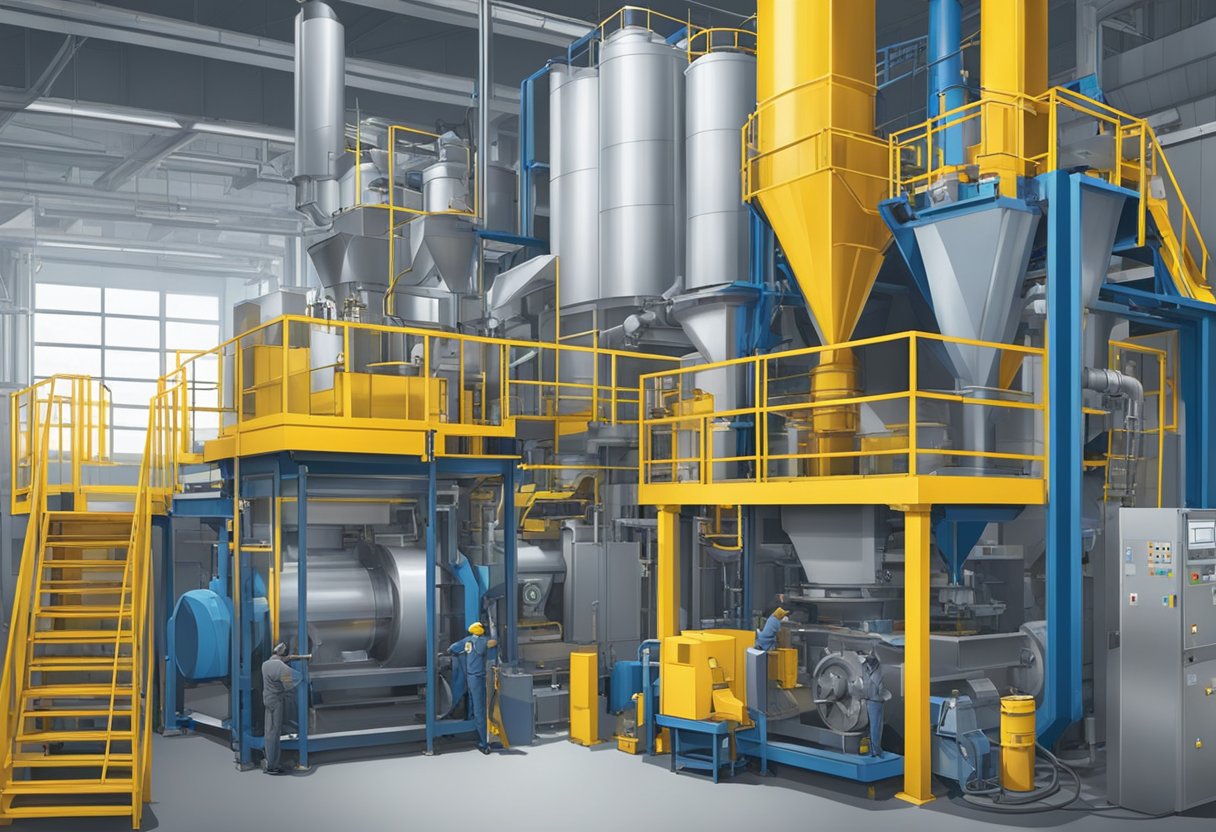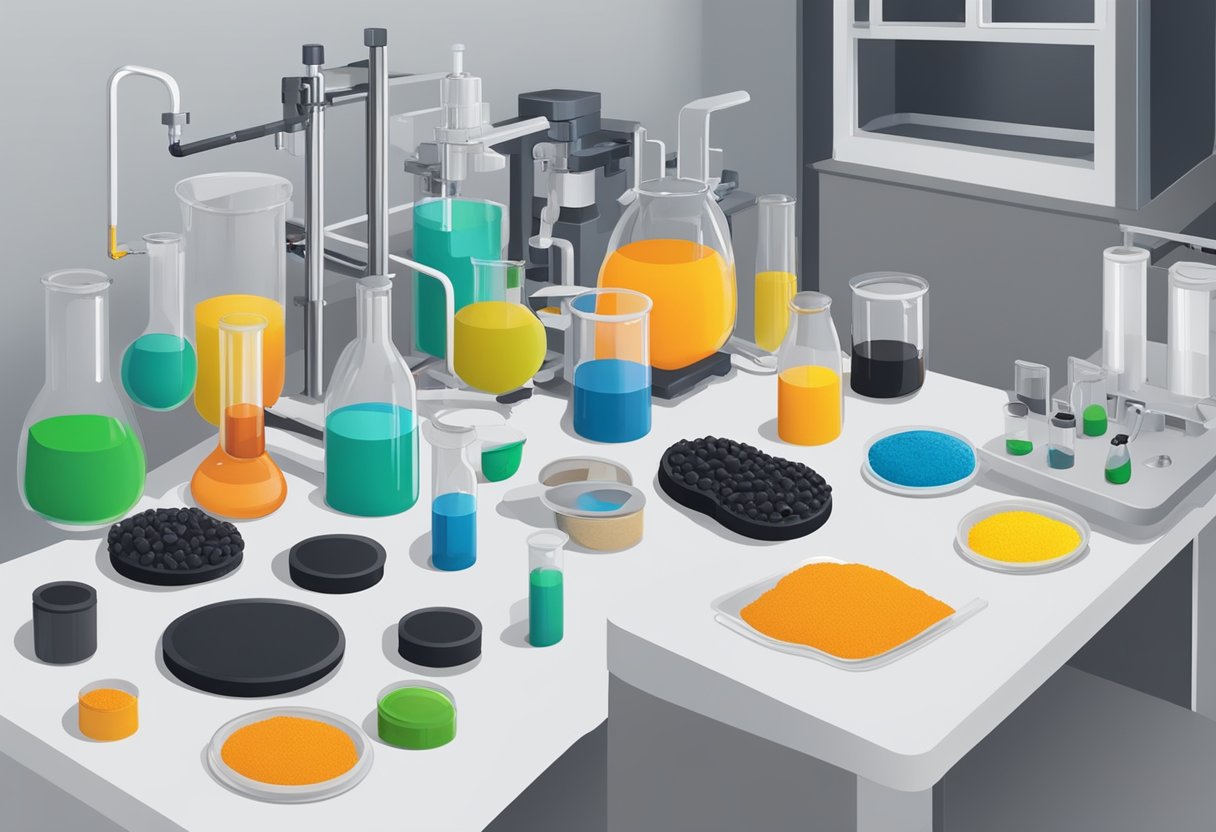TMTD Rubber: Properties, Uses, and Benefits
19/01/2024
TMTD rubber, also known as Tetramethylthiuram Disulfide, is a widely used accelerator in the rubber industry. It is a white or light yellow powder that is soluble in acetone, benzene, and carbon tetrachloride. TMTD rubber is commonly used in the production of tires, hoses, belts, and other rubber products.

TMTD rubber is known for its ability to improve the processing and vulcanization of rubber compounds. It helps to reduce the curing time of rubber and improve the physical properties of the final product. TMTD rubber is also known for its high thermal stability, which makes it ideal for use in high-temperature applications.
Despite its many benefits, TMTD rubber has been the subject of some controversy due to its potential health and environmental risks. Some studies have suggested that TMTD rubber may be toxic to humans and animals, and may have harmful effects on the environment. As a result, many rubber manufacturers are exploring alternative accelerators that are safer and more environmentally friendly.
Chemical Composition of TMTD

Thiuram Structure
Tetramethylthiuram disulfide (TMTD) is a sulfur-containing organic compound that belongs to the thiuram group. The chemical formula of TMTD is C6H12N2S4, and its molecular weight is 240.43 g/mol. TMTD is a white to light yellow powder that is soluble in organic solvents and slightly soluble in water.
The thiuram structure of TMTD consists of two methyl groups and a disulfide bond attached to a nitrogen atom. The thiuram structure of TMTD provides it with excellent vulcanizing properties, making it a popular accelerator in the rubber industry.
Additives and Stabilizers
TMTD is often used in combination with other accelerators and additives to enhance its properties and stability. For example, TMTD can be combined with dithiocarbamate accelerators to improve its curing properties and reduce its toxicity.
Stabilizers such as antioxidants and antiozonants can also be added to TMTD to prevent its degradation and extend its shelf life. The addition of stabilizers can also improve the performance and durability of rubber products that contain TMTD.
In summary, TMTD is a sulfur-containing organic compound that belongs to the thiuram group. Its thiuram structure provides it with excellent vulcanizing properties, making it a popular accelerator in the rubber industry. TMTD can be used in combination with other accelerators and additives to enhance its properties and stability. Stabilizers can also be added to TMTD to prevent its degradation and improve the performance of rubber products.
Production Process of TMTD

Raw Material Sourcing
The production of TMTD rubber involves the use of several raw materials, including tetramethylthiuram disulfide, sulfur, and accelerators. These materials must be sourced from reliable suppliers to ensure the quality of the final product. The purity and consistency of the raw materials are critical to the success of the production process.
Synthesis Methods
The synthesis of TMTD rubber typically involves a reaction between tetramethylthiuram disulfide and sulfur. The reaction is catalyzed by accelerators such as zinc oxide and stearic acid. The reaction takes place in a reactor vessel under controlled conditions of temperature and pressure. The resulting product is then washed, dried, and milled to produce a fine powder.
Quality Control
Quality control is an essential aspect of the production process of TMTD rubber. The quality of the final product is dependent on the quality of the raw materials and the accuracy of the synthesis process. Various tests are performed throughout the production process to ensure that the product meets the required specifications. These tests include tests for purity, particle size, and chemical composition. The final product is also subjected to rigorous testing to ensure that it meets the required performance standards.
In summary, the production process of TMTD rubber involves the careful sourcing of raw materials, the precise synthesis of the product, and rigorous quality control measures. The resulting product is a high-quality rubber that meets the required performance standards.
Physical Properties of TMTD

Melting Point
TMTD, or Tetramethylthiuram Disulfide, is a rubber accelerator that is commonly used in the production of rubber products. It has a melting point of approximately 155-158°C. The melting point of TMTD is important in the production of rubber products, as it helps determine the temperature at which the accelerator will be activated and begin to work.
Solubility
TMTD is soluble in a variety of organic solvents, including acetone, benzene, and toluene. It is also soluble in water at a concentration of approximately 0.5 g/L at room temperature. The solubility of TMTD is important in the production of rubber products, as it affects how easily the accelerator can be mixed into the rubber compound.
Overall, TMTD is a useful rubber accelerator with a melting point of approximately 155-158°C and solubility in a variety of organic solvents and water. Its physical properties make it a popular choice for use in the production of rubber products.
Applications in Rubber Manufacturing
Vulcanization Accelerator
TMTD rubber is widely used as a vulcanization accelerator in the rubber industry. Vulcanization is the process of converting natural or synthetic rubber into a more durable and stable material by cross-linking the polymer chains. TMTD helps to speed up the vulcanization process, resulting in improved mechanical properties of the rubber products. It also helps to reduce the curing time, which increases the production efficiency.
Rubber Additive Roles
Apart from being a vulcanization accelerator, TMTD also plays other roles as a rubber additive. It can act as an activator for other accelerators, enhancing their efficiency. It can also act as a scorch retarder, preventing premature curing of rubber compounds during processing. Additionally, TMTD can improve the aging resistance of rubber products, making them more durable and long-lasting.
Overall, TMTD rubber is a versatile and valuable material in the rubber industry. Its ability to act as a vulcanization accelerator and a rubber additive makes it an essential component in the production of high-quality rubber products.
Safety and Handling
Exposure Risks
TMTD rubber, like other rubber compounds, can cause skin irritation and sensitization upon prolonged or repeated contact. It can also cause eye irritation upon contact. Inhaling TMTD rubber dust or fumes may cause respiratory irritation, coughing, and shortness of breath. Long-term exposure to TMTD rubber may cause lung damage.
Protective Measures
To minimize exposure risks, it is recommended to wear appropriate personal protective equipment (PPE) when handling TMTD rubber. This includes gloves, goggles, and respiratory protection if necessary. Workers should also avoid skin contact with TMTD rubber by wearing long-sleeved shirts and pants.
In addition to PPE, proper ventilation is important when handling TMTD rubber. Work areas should be well-ventilated to minimize inhalation exposure. It is also important to avoid eating, drinking, or smoking in areas where TMTD rubber is handled to prevent ingestion.
Proper storage and handling of TMTD rubber is also important to minimize exposure risks. TMTD rubber should be stored in a cool, dry, and well-ventilated area away from direct sunlight and sources of heat and ignition. Workers should also avoid spilling TMTD rubber and clean up any spills promptly using appropriate methods.
Overall, following proper safety and handling procedures can help minimize exposure risks and ensure a safe working environment when handling TMTD rubber.
Environmental Impact
Degradation in Environment
TMTD rubber has been found to have a negative impact on the environment. When TMTD rubber products are disposed of, they can break down into harmful chemicals that can leach into the soil and water. This can lead to contamination of the environment and harm to wildlife. Additionally, TMTD rubber can release toxic gases when burned, contributing to air pollution.
Regulatory Status
TMTD rubber has been identified as a hazardous substance by various regulatory agencies. The European Chemicals Agency (ECHA) has classified TMTD as a substance of very high concern due to its potential to cause cancer and reproductive toxicity. The United States Environmental Protection Agency (EPA) has also identified TMTD as a hazardous substance and regulates its use and disposal.
In conclusion, the environmental impact of TMTD rubber is a cause for concern. It is important for manufacturers and consumers to take steps to minimize the negative impact of TMTD rubbers on the environment. This can include proper disposal of TMTD rubbers products and the use of alternative materials that are less harmful to the environment.
Storage and Stability
Shelf Life
TMTD rubbers has a limited shelf life, and it is essential to store it properly to ensure its quality and longevity. The shelf life of TMTD rubbers is typically six months to one year, depending on the storage conditions. After this period, the rubber may begin to degrade, leading to reduced performance and durability.
Storage Conditions
To ensure the stability and quality of TMTD rubbers, it is crucial to store it in appropriate conditions. Below are some guidelines for storing TMTD rubber:
- Store TMTD rubbers in a cool, dry, and well-ventilated area away from direct sunlight and heat sources.
- Keep TMTD rubbers away from sources of ignition, such as open flames or sparks.
- Store TMTD rubbers away from incompatible materials, such as strong oxidizers or acids.
- Keep TMTD rubbers in its original packaging or airtight containers to prevent contamination and exposure to air and moisture.
By following these guidelines, TMTD rubber can maintain its stability and quality, ensuring optimal performance and durability.
Performance Analysis
Efficacy in Rubber Compounding
TMTD (Tetramethylthiuram Disulfide) is a widely used rubbers accelerator that is known for its excellent scorch safety and fast curing rates. Its efficacy in rubber compounding is due to its ability to activate sulfur crosslinking, which helps to improve the physical properties of rubber products.
TMTD is particularly effective in natural rubbers and synthetic rubbers such as SBR (Styrene Butadiene Rubber) and NBR (Nitrile Butadiene Rubber). Its fast curing rates make it an ideal accelerator for the production of high-performance tires, conveyor belts, and other rubber products that require excellent physical properties and durability.
Comparison with Other Accelerators
Compared to other rubbers accelerators, TMTD has several advantages. For example, it has a lower risk of scorching, which means that it can be used in high-temperature processing without causing premature vulcanization. Additionally, it has a faster curing rate than many other accelerators, which can help to reduce production times and increase efficiency.
However, TMTD does have some limitations. For example, it can cause discoloration in some rubber compounds, which may be undesirable in certain applications. Additionally, it may not be as effective in certain types of rubber, such as EPDM (Ethylene Propylene Diene Monomer), which may require the use of alternative accelerators.
Overall, TMTD is a highly effective rubbers accelerator that offers excellent scorch safety and fast curing rates. Its efficacy in rubber compounding makes it an ideal choice for a wide range of rubber products, particularly those that require high performance and durability.
Market Trends
Demand Dynamics
The demand for TMTD rubbers has been steadily increasing over the past few years. This can be attributed to the growing demand for tires in the automotive industry. TMTD rubbers is a key ingredient in the production of high-quality tires. As the demand for tires increases, so does the demand for TMTD rubbers.
Another factor driving the demand for TMTD rubbers is the growth of the construction industry. TMTD rubbers is used in the production of various construction materials, including roofing materials, sealants, and adhesives. With the growth of the construction industry, the demand for TMTD rubbers is expected to continue to rise.
Supply Chain Factors
The supply of TMTD rubbers is heavily dependent on the availability of raw materials. The primary raw material used in the production of TMTD rubbers is tetramethylthiuram disulfide. The availability of this raw material can be affected by a number of factors, including weather conditions and geopolitical events.
Another factor that can impact the supply of TMTD rubbers is the availability of skilled labor. The production of TMTD rubber requires a high level of skill and expertise. If there is a shortage of skilled labor, the production of TMTD rubber may be impacted.
Overall, the market trends for TMTD rubbers are positive. With the growing demand for tires and the continued growth of the construction industry, the demand for TMTD rubbers is expected to continue to rise. However, supply chain factors such as the availability of raw materials and skilled labor may impact the supply of TMTD rubbers in the future.
Innovations and Research
Recent Technological Advancements
In recent years, there have been several technological advancements in the production of TMTD rubbers, which have improved its properties and performance. One such advancement is the use of nanotechnology, which involves incorporating nanoparticles into the rubber matrix to enhance its mechanical, thermal, and electrical properties. This has resulted in the development of high-performance TMTD rubbers products that exhibit excellent tensile strength, tear resistance, and abrasion resistance.
Another technological advancement in TMTD rubber production is the use of advanced compounding techniques, such as twin-screw extrusion and continuous mixing, which have improved the homogeneity and consistency of the rubber compound. This has resulted in TMTD rubber products that exhibit better processing characteristics, such as faster curing times, higher vulcanization rates, and improved flow properties.
Ongoing Research Areas
Despite the significant advancements in TMTD rubbers production, there are still several ongoing research areas that aim to further improve its properties and performance. One such area is the development of sustainable and eco-friendly TMTD rubbers products, which can be produced using renewable resources and reduce the environmental impact of rubber production.
Another ongoing research area is the development of TMTD rubbers products with enhanced functional properties, such as self-healing, self-cleaning, and self-lubricating properties. This involves incorporating functional additives into the rubber matrix, which can improve its performance in specific applications, such as automotive, aerospace, and biomedical applications.
Overall, the innovations and ongoing research in TMTD rubbers production are expected to lead to the development of high-performance and sustainable rubber products that can meet the evolving needs of various industries.
Frequently Asked Questions
How does TMTD function as an accelerator in rubber compounding?
TMTD, or Tetramethylthiuram disulfide, is a sulfur-based organic compound that acts as an accelerator in rubber compounding. It promotes the cross-linking of rubber molecules, which leads to the formation of a stronger and more durable material. TMTD works by reacting with the sulfur atoms present in the rubber molecules, which results in the formation of disulfide bonds. These bonds help to increase the strength and elasticity of the rubber.
What are the primary uses of Tetramethylthiuram disulfide in the rubber industry?
TMTD is commonly used in the rubber industry as an accelerator for the vulcanization of natural and synthetic rubber. It is also used as a secondary accelerator in combination with other accelerators such as MBTS and CBS. Additionally, TMTD is used as a fungicide and pesticide in agriculture.
What role does MBTS play in rubber compounding?
MBTS, or 2,2′-Dibenzothiazyl disulfide, is a sulfur-based organic compound that acts as an accelerator in rubber compounding. It is commonly used in combination with TMTD to promote the cross-linking of rubber molecules. MBTS works by reacting with the sulfur atoms present in the rubber molecules, which results in the formation of disulfide bonds. These bonds help to increase the strength and elasticity of the rubber.
How does CBS differ from TMTD in rubber vulcanization?
CBS, or N-Cyclohexyl-2-benzothiazolesulfenamide, is a sulfur-based organic compound that acts as an accelerator in rubber vulcanization. It is similar to TMTD in that it promotes the cross-linking of rubber molecules, but it has a slower rate of reaction. CBS is often used in combination with TMTD to achieve a more controlled vulcanization process.
What are the safety considerations when handling TMTD in rubber manufacturing?
TMTD is a hazardous substance and should be handled with care. It can cause skin and eye irritation, and prolonged exposure can lead to more serious health effects. Rubber manufacturers should take appropriate safety precautions when handling TMTD, including wearing protective clothing and gloves, and ensuring adequate ventilation in the workplace.
Can TMTD be used in combination with other accelerators for rubber processing?
Yes, TMTD can be used in combination with other accelerators such as MBTS and CBS to achieve a more controlled vulcanization process. The use of multiple accelerators can help to optimize the vulcanization process and improve the properties of the final rubber product. However, it is important to carefully select the appropriate combination of accelerators to avoid any negative interactions.




